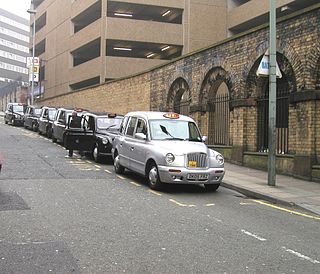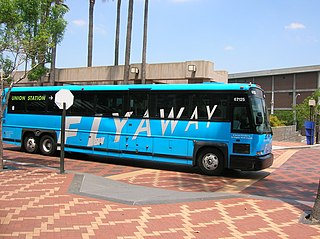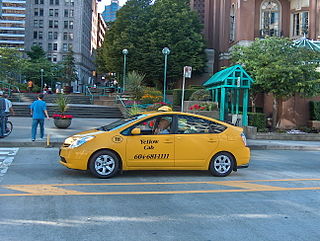
Queue areas are places in which people queue for goods or services. Such a group of people is known as a queue or line, and the people are said to be waiting or standing in a queue or in line, respectively. Occasionally, both the British and American terms are combined to form the term "queue line".

A hackney or hackney carriage is a carriage or car for hire. A hackney of a more expensive or high class was called a remise. A symbol of London and Britain, the black taxi is a common sight on the streets of the UK. The hackney carriages carry a roof sign TAXI that can be illuminated at night to indicate their availability for passengers.

Brighton railway station is the southern terminus of the Brighton Main Line in England, and the principal station serving the city of Brighton, East Sussex. It is 50 miles 49 chains from London Bridge via Redhill.

In New York City, taxicabs come in two varieties: yellow and green; they are widely recognizable symbols of the city. Taxis painted yellow are able to pick up passengers anywhere in the five boroughs. Those painted apple green, which began to appear in August 2013, are allowed to pick up passengers in Upper Manhattan, the Bronx, Brooklyn, Queens, and Staten Island. Both types have the same fare structure. Taxicabs are operated by private companies and licensed by the New York City taxi and Limousine Commission (TLC). It also oversees over 40,000 other for-hire vehicles, including "black cars", commuter vans, and ambulettes.

A motorcycle taxi, or cart bike or bike taxi, is a licensed form of transport in some countries. The taxi typically carries one passenger, who "rides pillion" behind the motorcycle operator. Multiple passengers are common in some countries.

The transport system of Kolkata, a city in India, is a mix of modern mass rapid transport and old transport modalities like rickshaws. Kolkata is connected to the rest of India by the National Highways, the extensive network of the Indian Railways, National Waterways and by air. The most traffic to Northeast India route via Kolkata.

London has an extensive and developed transport network which includes both private and public services. Journeys made by public transport systems account for 37% of London's journeys while private services accounted for 36% of journeys, walking 24% and cycling 2%. London's public transport network serves as the central hub for the United Kingdom in rail, air and road transport.
Taxicabs in a single country often share a set of common properties, but there is a wide variation from country to country in the vehicles used, the circumstances under which they may be hired and the regulatory regime to which these are subject.
The taxicabs of the United States make up a mature system; most U.S. cities have a licensing scheme which restricts the number of taxicabs allowed. As of 2012 the total number of taxi cab drivers in the United States is 233,900; the average annual salary of a taxi cab driver is $22,820 and the expected percent job increase over the next 10 years is 16%.

Taxicabs are regulated throughout the United Kingdom, but the regulation of taxicabs in London is especially rigorous with regard to mechanical integrity and driver knowledge. An official report observed that: "Little however is known about the regulation by anyone outside the trade. The Public Carriage Office (PCO), which regulates and licenses taxis and private hire was transferred from the Metropolitan Police to become part of Transport for London in 2000." In 2015, there were around 298,000 licensed drivers in England, of which 164,000 were private hire licences, 62,000 were taxi licences and 72,000 were dual licences.
Illegal taxicabs, sometimes known as pirate taxis, gypsy cabs, or jitney cabs, are taxicabs and other for-hire vehicles that are not duly licensed or permitted by the jurisdiction in which they operate. Most major cities worldwide require taxicabs to be licensed, safety-inspected, insured as for-hire vehicles and use taximeters and there may also be requirements that the taxi driver be registered or accredited. However, many unlicensed cabs are in operation. Illegal cabs may be marked taxi vehicles, and others are personal vehicles used by an individual to offer unauthorized taxi-like services. Illegal cabs are prevalent in cities with medallion systems, which restrict the number of legal cabs in operation. Since their introduction in 2009, vehicles affiliated with the transportation network company Uber have been classified as illegal taxicabs in some jurisdictions.

Beijingnan railway station is a large railway station in Fengtai District, Beijing, about 7.5 km (4.7 mi) south of central Beijing, between the 2nd and 3rd ring roads. The station in its present form opened on 1 August 2008 and replaced the old Beijing South station, originally known as Majiapu railway station and later renamed Yongdingmen railway station, which stood 500 metres away. The old station was in use from 1897 to 2006.

An airport bus, or airport shuttle bus or airport shuttle is a bus used to transport people to and from, or within airports. These vehicles will usually be equipped with larger luggage space, and incorporate special branding. They are also commonly painted with bright colours to stand out among other airport vehicles and to be easily seen by the crews of taxiing aircraft when negotiating the aprons.

Chicago, Illinois is the third-largest city in the United States and a world transit hub. The area is served by two major airports, numerous highways, elevated/subway local train lines, city/suburban commuter rail lines, it is the national passenger rail hub for Amtrak routes, and is the main freight rail hub of the North American continent.
Shanghai has an extensive public transport system, largely based on buses, trolley buses, taxis, and a rapidly expanding metro system. Shanghai has invested heavily in public transportation before and after the 2010 World Expo, including the construction of the Hongqiao transportation hub of high-speed rail, air, metro and bus routes.

A taxi, also known as a taxicab or simply a cab, is a type of vehicle for hire with a driver, used by a single passenger or small group of passengers, often for a non-shared ride. A taxicab conveys passengers between locations of their choice. This differs from public transport where the pick-up and drop-off locations are decided by the service provider, not by the customers, although demand responsive transport and share taxis provide a hybrid bus/taxi mode.

Cars such as Toyota Etios, Maruti Omni, Mahindra Logan, Tata Indica and Tata Indigo are fairly popular among taxicab operators. The livery of the taxicabs in India varies from state to state. In Delhi and Maharashtra, most taxicabs have yellow-black livery, while in West Bengal, taxis have yellow livery. Private taxicab operators are not required to have a specific livery. However, they are required by law to be registered as commercial vehicles.

Hybrid taxi or hybrid electric taxi is a taxicab service provided with a hybrid electric car (HEV), which combines a conventional internal combustion engine propulsion system with an electric propulsion system.
Public transport in Lima is handled by buses, micros, taxicabs, and the so-called mototaxis. Micros are the most common means of public transportation in Lima and many other cities in Peru. There are also more than 100 kilometres (62 mi) of cycle paths in the city.

Boro taxis are taxicabs in New York City that are allowed to pick up passengers in outer boroughs and in Manhattan above East 96th and West 110th Streets. The color of boro taxis is apple green in contrast to the traditional yellow taxis in New York City.


















